My newly adopted grandmother and grandfather are certainly old school in how they live -- they're up every day at 4am to do all the chores that need to be done, like picking vegetables or making presentations to the gods which live all around their country house. I decided to emulate them while I was on their island, for a couple of days at least. Well, I knew I would never be able to get up at 4am, but I wanted to enjoy all the clean-living fun of rural Japan -- working in the fields, taking the dog for a walk in the bamboo thickets, drinking warm sake under the warm warm kotatsu. On my first full day in Shikoku, I was able to participate in another chore, a particularly sacred one -- the making of mochi rice cakes.
Before we go on, I ought to explain... what are mochi rice cakes, exactly, and what do they mean to the Japanese people? Let's go to one of the popular sources of modern times: Wikipedia! Wikipedia says: "Mochi (Japanese 餅) is the Japanese variant of Chinese rice cake, which, like its Chinese origin, is made of glutinous rice, pounded into paste and molded into shape; however, unlike the Chinese variety, it is molded right after it is pounded, whereas the Chinese variety is baked once again after to solidify the mixture as well as sanitize it. Traditionally in Japan, it is made in a ceremony called mochitsuki. It may also be made in an automatic mochi machine, similar to a breadmaker. In Korea, a nearly identical food is called duk (also spelled dduk, duek, d'uk, or tteok)." (Ed's note: those Koreans have a knack of giving the same basic food a million different names -- see my Korean Dog Soup Page for more comfirmation of this!)
On the subject of Mochitsuki, which is the ceremony I was blessed to participate in, Wikipedia continues: "Polished glutinous rice is soaked overnight and cooked (eds note: see first picture in the series below: the rice is being steamed in a traditional mushiki here.) The rice is pounded with wooden mallets (kine) in a traditional mortar (usu). Two people will alternate the work, one pounding and the other turning and wetting the mochi. The mochi must be kept wet to keep it from sticking to the mallet. The sticky mass is then formed into various shapes (usually a sphere or cube)."
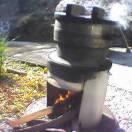
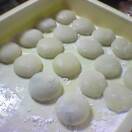
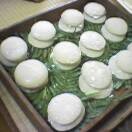
That's making mochi in a nutshell: a lot of steaming, a lot of pounding, and a lot of kneading into the desired usually moon-like shape. What you end up with a lump of soft, sticky, gooey, glutinous goodness. They taste somewhat bland perhaps, although you can spice them up coating them with various substances, or stuffing them with red bean paste or even ice cream (that last item is not particularly old school though!) In the photo block beneath you can see another variant being made -- grass mochi! Kusa mochi (Japanese: 草餅), also known as yomogi mochi, is a Japanese sweet, and despite the name is made not from grass but rather mugwort.


Yes sirree, the Japanese love cooking and eating these rice cakes at New Years Eve, although they are often eaten elsewhere in the year. Japanese also love presenting the mochi to the gods, to thank and honor them and to ensure good fortune in the following year. It is interesting that throughout human history, all over the world people have felt compelled to offer sacrifices to the Higher Beings, in order to win their appeasement and their approval. I was reading Homer's The Odyssey last year, and what impressed me the most, apart from the brutality of the climax, was how on almost every second page one of the heroes burnt up a pile of bovine thigh bones, or a rack of juicy steaks, to satisfy Zeus and his ilk. Now they don't practice animal sacrifice in Japan, but they do have plenty of reverence for the gods -- and there are literally millions of gods in this country. They don't sacrifice animals, but they do sacrifice food, which must have meant a big loss of resources back in the old days when there were a lot of hungry mouths to feed.
One thing I ought to point out right here is that New Years Day is celebrated in a completely different way in the East than it is in the West. In Japan/Korea/China/Vietnam New Years Eve/Day is kind of similar to the western idea of Christmas in that it is a day for family get-togethers, quiet reflection and acts of religious devotion, the consumption of vast quantities of food, dozing off in armchairs, getting up late and basically taking it easily. Ironically, Christmas Eve is the time to party in Japan, and many couples ask each other out on dates on this day; going to Kentucky Fried Chicken is especially popular. Go figure! So in other words, the Japanese New Year is our Christmas, and our New Year is their Christmas, in a manner of speaking! One of the things Japanese people do on New Years Day, apart from eating and drinking a lot of substances themselves, is that they make offering to the gods. At the home of my adopted family in Shikoku, they honor and partake in a particular tradition, which I call making mochi trees. Actually, it is only one tree they make, a small typically Japanese bonsai style fake tree, basically a stick skeleton hung with colorful shiny baubles and -- get this -- little pieces of mochi, rolled up to make what are called mochibana (rice cake flowers). The little stick tree is then propped up in front of the household altar, in the belief that the gods will come and eat the flour flowers, while the humans are off enjoying themselves devouring osechi ryori and sinking sake elsewhere in the house.


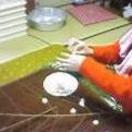
In the photo bar above, you can see mochibana being applied to the branches of the fake tree, by my girl C. In the photo bar beneath, you can see the mochi tree in all its colorful glory, before the household altar. The final photos display more substantial fare for the gods -- a full tray of shrinkwrapped rice cakes ready for Divine Degustation. There are also some dried kaki (persimmon) and a whole salted fish, if any spiritual beings take a fancy to that.

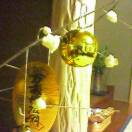
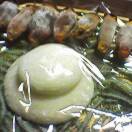
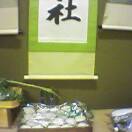
The idea of leaving fish and dried foods on an altar in your house for invisible beings to eat might seem strange to us westerners, but we do have some similar practices of our own. In a lot of countries people leave out glasses of warm milk (or cold beer, in Australia) for Santa Claus to drink on his annual visit, and there is a carrot in every house for the Easter Bunny. In some countries, children who have lost teeth put them in a glass of water beside their bed, and in the morning they are transformed into money! Perhaps Santa and the Easter Bunny and the Tooth Fairy are all we left of our pagan animist past. In Japan in the animist past lives on. In Japan animism never died.
Like many other things in Japan, mochi plays a spiritual role in life. Every village or town has its own special ways of using it in its religious rites and customs. In the small town of Aratano (Tokushima Prefecture) in Shikoku, for example, a festival is celebrated in the early New Year called Mochi Nage, or "Thrown Mochi". The idea behind Mochi Nage is disarmingly simple: people turn up at the local Shinto shrine, some shrine workers come out with bags of cooked (and I assume blessed) rice cakes, wrapped in plastic for hygiene, and proceed to hurl them at the assembled crowds. Little kids dash about, catching or picking up as many of the rice cakes as they can bundle into their arms. Old ladies push younger countrymen/women aside in the mad melee. Perhaps some fire works are discharged. At the Mochi Nage festival I attended at Aratano, I got pelted by a couple of the thrown cakes, which are actually quite hard and could easily "take an eye out", if you were hit the right way. I also managed to collect a big bag full of mochi, and this bag was eyed enviously by some of the local kids in attendance there. The gods were on my side; I managed to do a good job.
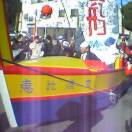



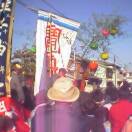
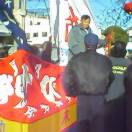
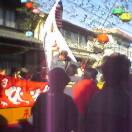

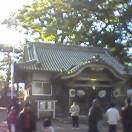
In the photo bar above, you can see photos from the Mochi Nage festivities at Aratano. In this town's version of Mochi Nage, a colorful boat-like vehicle (actually a converted car) is first rolled through the streets, attracting a crowd of eager scavengers. Like a Pied Piper, the car led us on to the local shrine where the proper rice cake chucking and catching sessions began -- and as I already mentioned, I ended up scooping up much of the venerable little goodies (attribute that to luck, or perhaps to favor of the mochi gods!)
Whether we be human or animal or vegetable or god, all we want is the same thing in life: recognition for our existence and our efforts, and perhaps a bit of love and respect served on the top. That is what mochi encapsulates, and celebrates: the awareness that life is a ritual in which everyone must play their part, and in which every part is glorious. Witness the life cycle of this critter: pounded out of generous grains nurtured by the Four Elements, molded into moon shapes, then offered to the local deities, or tossed to little kids and grandmothers at the shrine... isn't this all just a celebration of the earth, a celebration of what the Earth can offer? We take from the earth and give back to it, and then it gives back to us, etc. The cycle keeps on repeating, endlessly. Creating abundance out of scarcity, rebirth out of decay, a New Year from the Old. The cycle never ends. The gods of Shikoku taught me all this, and more. In time, I might teach them a thing or two! In a couple of lifetimes or so.

This comment has been removed by the author.
ReplyDeleteThis comment has been removed by the author.
ReplyDelete